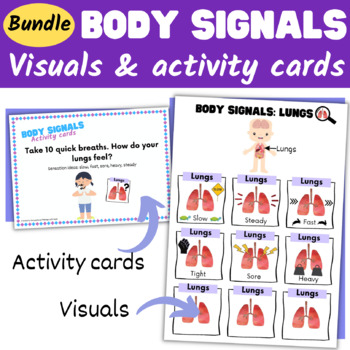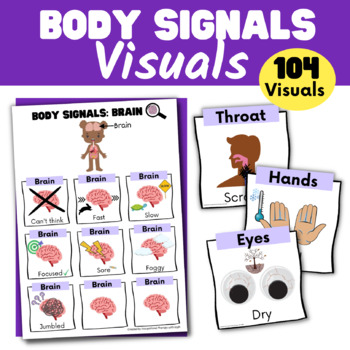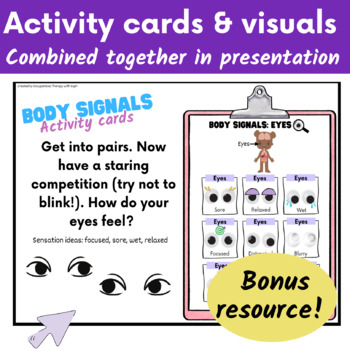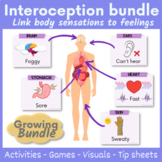Body Signals Visuals & Activity Cards Bundle - Interoception Activities
- Zip
Products in this Bundle (2)
Bonus
Also included in
- Are you looking for engaging interoception activities / games to help your students identify their own emotions? This best selling interoception bundle is full of excellent social and emotional learning (SEL) resources to support students to develop their ability to recognise their own internal bodyPrice $37.80Original Price $47.25Save $9.45
Description
This new interoception activities bundle brings together two great products - body signals visuals and body signals activity cards. These interoception resources complement each other in supporting students to notice their body signals / sensations and help them start to notice how they might feel in different situations.
The best bit?
I’ve also created a bonus resource! The resource is a presentation combining the activity card activities and matching them with the relevant visuals. This bonus interoception resource is only available for purchase in this bundle and my larger interoception bundle!
The visuals
These Interoception visuals are a fantastic addition to your toolbox to support your social and emotional learning lessons! It features 104 different body signals to use in the classroom or therapy room.
These engaging interoception visuals help people of any age to tune into their own body signals and build their vocabulary to describe these signals. Being able to identify and then link body signals to feelings and emotions is a critical step for emotional regulation. Recognising and managing body signals helps build resilience to support people of all ages.
I use these interoception visuals all the time! Here are some ideas on how to use:
- Use with body sensations / interoception activity cards. Complete body signal activity and then use visuals to support students to describe how their bodies are feeling.
- Pick cards out to describe what happens in your body when you feel happy, tired, sad, worried, angry, hungry, etc.
- Use in body mapping activities to help build students' body signals vocabulary.
- Use with interoception activity cards or body experiments to support interoception awareness.
- Use before & after brain breaks. For example, you may run yoga in a session as a brain break. Use the visuals before yoga moves to tune into different body sensations (maybe their brain might feel ‘jumbled’). Then after completing the brain break use signals to help support students to identify how their body has changed (maybe their brain might now feel ‘focused’).
104 different body signals / sensations are provided over the following body areas:
- Hands
- Feet
- Skin
- Cheeks
- Eyes
- Ears
- Nose
- Mouth
- Throat
- Brain
- Muscles
- Lungs
What's included
- 104 different body signals / sensations
- 2 versions of body signals / sensations provided:
- Version 1: Individual PDF files for each signal / sensation (104 pages)
- Version 2: Body signals sorted into each body areas (e.g. skin, heart, lungs, etc) (16 pages)
Please note all visuals are in colour with white backgrounds
The activity cards
This resource includes 25 interoception activity cards designed to help students notice and tune into their own body signals. These activities can be used as a warm up before SEL lessons, as brain breaks, as the main activity, or sent home to practice tuning into body signals.
Each activity card asks students to complete a different task and then prompts them to tune into a body signal / sensation. For example: “run on the spot for 30 seconds, now place your hand over your heart. How does your heart feel?”. Cards also feature ‘sensation ideas’ with different prompts on how they might be feeling.
Activity cards now come with a 'challenge card'. The challenge card is set out in a bingo-style format to encourage students to complete as many body signal activities as they can. Hang the challenge card in the classroom and complete activities each day and cross off as you go to keep track. Use a brain break in between lessons or send it home for students to complete 'interoception challenges' with their families.
How to use
- Discuss with students that you will be completing activities together to learn about different body signals / sensations. We all experience different sensations in our body and these body sensations give us clues to how we feel. You might like to give some examples of body signals / sensations: “Has anyone ever felt their stomach growl? This sensation tells us we might be hungry. How about the tight feeling in your stomach if you need to pee?”
- Choose an activity card and read it aloud.
- Complete the activity with students.
- Ask students what sensations they noticed, has anything changed (e.g. is their heart faster or slower)? Sensation ideas are also provided on each card to use for prompting if needed.
What's included
- 25 activity cards (pdf).
- Challenge card - 2 versions of the Challenge bingo card provided:
- Version 1: Large bingo card with 20 interoception activities (4x5 grid) 1 page pdf.
- Version 2: Two small bingo cards with 9 interoception activities per card (3x3 grid) 2 pages pdf. (Please note the activities are the same as the activities included in the large bingo card). This version may be more appropriate for younger learners.
Products you’ll also like
Lets connect :)
- Follow me on Instagram for helpful tips
- Join my email list to stay up to date and for freebies
- Follow my store to stay up to date on all new products (which are always discounted for the first 48 hours!)
Disclaimer
These activities are intended for general use. This activity is not intended to replace the advice of a physician or occupational therapist. Information provided should not be used for diagnostic or training purposes. If you require specific support contact your physician or OT. Stop any activity if you are unsure about a child’s reaction or ability.
Copyright Occupational Therapy with Soph
All rights reserved by the author. This resource is licensed only for the educator or clinician who purchased it. You may share with your own students or caseload.
Questions
Any questions, comments, feedback, or requests please reach out to me via TPT or at sophia.occupationaltherapy@gmail.com






